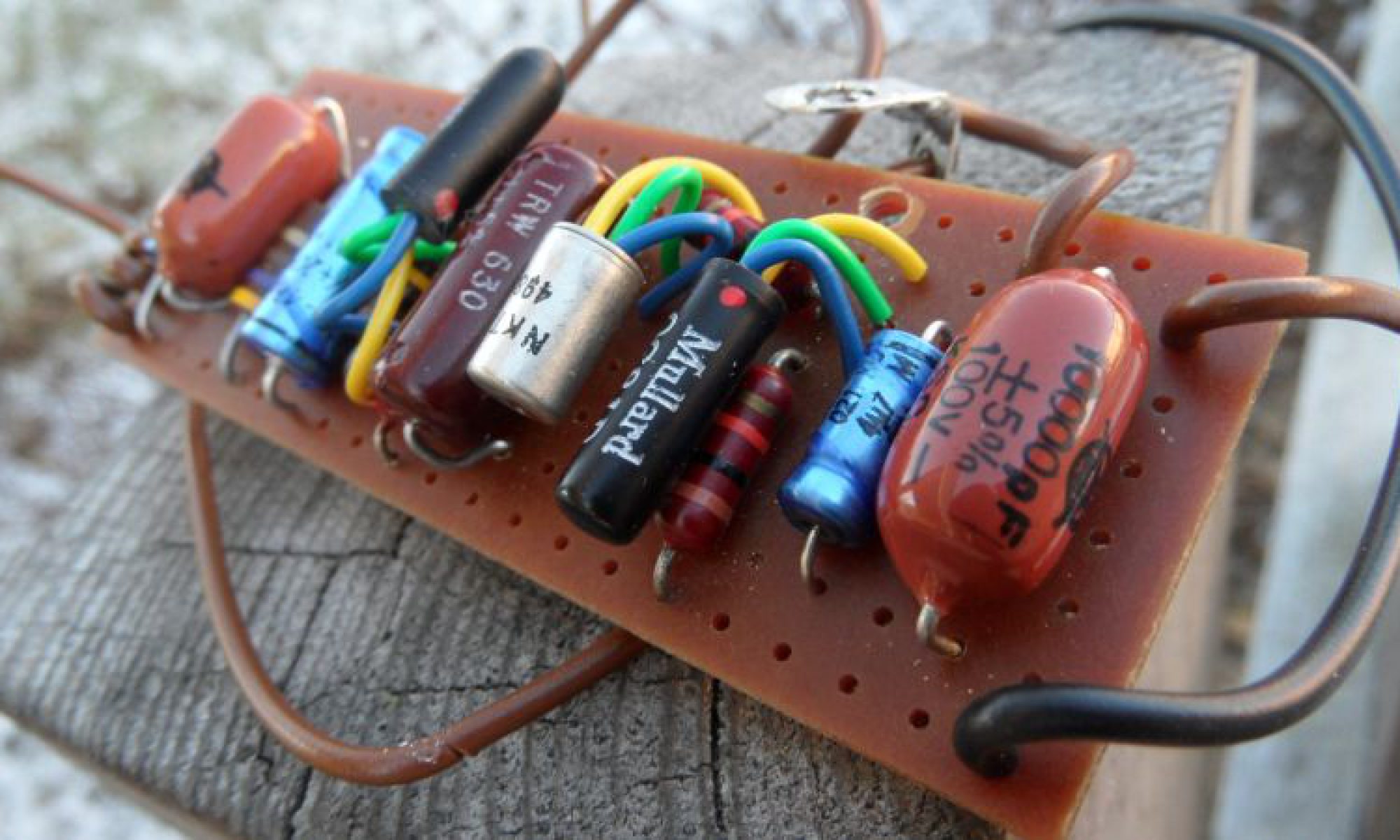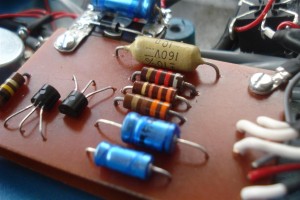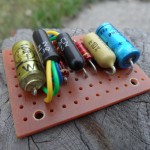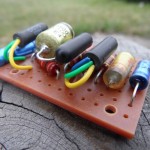Yet another Ibanez fuzz 😉 Vintage stuff
Actually fuzz part of Ibanez Double Sound Fuzz/Wah
0,15″ and 0,1″ pitch vero projects
Big one is big, small one is smaller – small enough to fit Hammond B
Have fun

Boards and turrets! Yeah!
 Welcome to new section. Since t.org shows at least few projects based on good-ol Fuzz Face I decided to keep them all in one room. This is also good time to look at them again – correcting possible errors and update with new info.
Welcome to new section. Since t.org shows at least few projects based on good-ol Fuzz Face I decided to keep them all in one room. This is also good time to look at them again – correcting possible errors and update with new info.
Firstly – let’s look at Dunlop EJ-F1 Eric Johnson Fuzz Face. Attached project is based on 0,1″ pitch perfboard layout done at one point by Electric Warrior, with specific components added to match EJ-F1 spec, full off-board wiring as usual, no shielded wire, just like in real one.
So what we have here is basically standard Fuzz Face spec, originally Q2 resistor is paired with trimmer to set quite cold bias at 3v range. I decided to do it as an fixed bias for layout simplify and vintage look of sake of it. Just set the bias with potentiometer, pick the closest value resistor from your stash and solder it in.
What we also see here is small value capacitors between transistors Collector and Base. In traced unit at Freestompboxes there is only Q2 limiting cap, SMD type, no marking visible, but it shouldn’t be big. Our B.man have one coming soon, so as soon as we get the correct info, let’s say it’s about 39pF. For Q1 there is no cap, but there is a place for one, perhaps in later issues, when/if/in case if Dunlop will use hotter transistors for Q1 this cap will be there, at this point with recommended transistor pair omit the fucker.
Lastly, we have small value 27R resistor in line with 15uF cap to prevent squealing and few shifts in component values making this unit unique. Give it a try!
And here is the same as abowe, but for .15″ pitch retro-style vero. Will fit into hammond 125B enclosure, nice and old-school
———-
Another Dunlop Fuzz Face variant – Joe Bonamassa Signature Fuzz Face.
As my previous layout, this perfboard is based on Electric Warrior’s work with just few components added to match it to JBF-3 spec.
What’s the Fuzz is All About? Firstly, it has one more component to (AFAIK) prevent squealing at higher Fuzz settings.
Secondly, it’s PNP germanium circuit. Old stock Russian transistors ware used.
JBF-3 was short lived limited to 300 units only. It’s gone by now, so here’s your chance to build one.
I did another layout with external bipolar power supply, but I wasn’t sure connections, so I decide to let you see it as is – bare bone.
Get your PDF project file here (project revision 2 – final error corrected)
Enjoy
———-
Another project is is made for 0,15″ pitch veroboard. It’s classic Dallas Arbiter silicon BC183L Fuzz Face. First Si transistor issue. Wide space vero I did is still small enough to be fit into Hammond B style enclosure. No mods, no fucking around, just a plain and simple silicon Fuzz Face we all love, and hate…
———-
John Hollis RockFace
Here’s description from John Hollis website
What we see here is slightly twicked (to JBF3 spec) Fuzz Face circuit with Q2 collector autobias. How cool is that?
Few notes:
– Draw designed to accommodate C-E-B short leg transistors as I have quite large stash of old Russian Ge’s with that pinout. It shouldn’t be a problem since most ge’s are long legged, you can bend them as you wish…
– It’s not exact RockFace schematic take. 100n in John’s is 10n in my layout, 47uF cap from mid lug fuzz pot to V+ is standard 22uF in mine. I’ve added 10R anti-squeal resistor in line with that 22uF, as known in Dunlop JHF3 Fuzz Face. Pot values are also taken from new-ish Dunlop FF’s
– Triple checked – not verified
Small enough to be fit into B sized Hammond enclosure, I’ve draw it with 0,1″ pitch stripboard in mind
———-
More variants coming soon…
———-
Two different effects, shared (almost) the same component layout.
Very lush sounding units I must admit.
As most of effects from Colorsound line classic and adored!
Power Boost was recently reissued by Macari’s with Castledine Electronics colaboration
Transistor info: Factory schemo shows BC109C’s but AFAIK those ware never seen in reality. What we see usually is BC169B’s or BC349B (and mix of both) in vintage units, and reissues with BC184L (also seen in vintage Powerboost) or BC184C. Use any NPN Silicon’s with similar spec.
Big hug and high fife to monkeyxx from FSB forum for cool mod ideas.
What you get below is two versions of Power Boost named as Early, and Later spec, and an Overdriver. Another three docs contains the same shit, but in different flavor as per monkeyxx instructions – added master volume control, changed drive pot taper.
Taste it, you’ll love it
Modified:
– Power Boost Early Spec (Monkeyxx Mods)
Hammond B-sized enclosure friendly. More of description coming soon
Tone Bender MK2 Professional revision2
VOX Tone Bender – or JEN Fuzz, those are the same. I made vero layout that matches PCB pattern, for those who (like me) don’t like to play with chemicals at home. Component values matches my JEN unit. I’ve seen some differences in other VOX/JEN units, like 15uF electros, or different input cap values, but the ones listed in .pdf are most common from those I’ve seen. I’ve made my document with Tropical Fish Caps in mind, if you’re going to use other (axial) caps this can be easily modificated, just move the line, and the trace cuts as I did in my clone below. If you need assistance, @ me.
Tone Bender MK1 Vero – description in progress
Tone Bender MK1 on perfboard – exact repro, full off-board shielded wiring. This is the very first one from the whole family, originally build point to point on perfboard.
Tone Bender MK I.V.pdf – Very alike to good old Fuzz Face, but sounds not the same. Replica layout, full off-board wiring with shielded wire, as original – no LED, no power supply socket.

Another MKII variant. Or like I like to call it MK 1-3/4, or STFU (Short-Circuit-Board Transitional Fuzz Unit). As I said above it’s basically earliest know to mankind MKII, build around of MK I.V vero design. Few components ware added, but still lacks pull-down capacitor on the input. It have unique sound compare to later MK Two’s. Below, two versions available to download, minor differences, but they are exist:
– Sola Sound/D*A*M SCB Reissue.pdf – current D*A*M/Macari’s reissue, also known as Blue Meanie
– Sola Sound/D*A*M SCB Reissue + 100R Limiting Resistor.pdf – I’ve seen just one unit like this – actually one picture of one unit, but it was easy to draw. Other MK2’s (Marshall Supa-Fuzzes) with limiting resistors I’ve seen always had 100R there (color code is not visible here). AFAIK not many was made, just a couple for Mr.Main own amusements, but worth mentioning
– Original Short Circuity 60’s version.pdf – stock, vintage spec
Standard Tonebender Professional MKII, this is the layout of MKII we see most of the times. No surprises here, replica layout, again full shielded wire off-board wiring, no LED, no power supply socket – MKII Professional.pdf
The same as above, the only difference is 15000pF input and output caps resulting deeper tone. This spec is often seen in Sola/D*A*M reissue creations, as well as in some VOX MK2 Pros and Marshall Supa Fuzz. Download .pdf project file here
All presented layout includes full off-board wiring with shielded wire, no LED, no power supply socket – as original!
Here’s MK3 and MK4’s vero layouts. Those was build on PCB’s originally so this is not direct replica. I had mine C-E-B short leg transistors in mine drawing this (you can use any long leg transistors really with no problem), as well as those sexy orange Philips MKT’s. Tropical Fish caps will also fit here nicely.
Tone Bender MKIII – Early Spec
Tone Bender MKIV Later 1970-72 Spec
Tone Bender MKIV 1972-76 Batman Logo
Here’s few more MK3(isch) projects. What’s common to those above is transistor pinout, and overall layout in most of the cases. Those all basically belongs to TBMK3/4 family, so I decided to post them here:
DAM Fuzz Sound Black On Black Limited Edition
DAM Mother Fucker limited custom project – Grease and Smoke sides done as an independent units
Prescription Electronics – Yard Box
Another MKII. This is what I did after moving parts around in DAM Professional MkII I did recently.
Basically this is the same thing than DAM’s discontinued MKII, with on-board Q2 bias trimmer – only smaller. Small enough to fit into B sized hammond brand (or similar) enclosure. Use 0.1″ pitch stripboard, radial ecaps, small raster (5mm) 10nF and 100nF caps like Panasonic SMF, or Xicon Greenies and 1/4W resistors of your flavor, then enjoy Pocket Bender.pdf
Now – Back On Tag! Two new tagboard layouts for Tone Benders.
Standard schematic, you can build shitload of Bender variants including Marshall Supafuzz Input cap-to-ground can be easily take off the circuity without moving parts around, or use small-ass SPDT to switch it on or kick it out. Layout includes fully shielded off-board wiring and mojo vibe.
Another one is Tone Bender Mk I.V similar apparition, based on standard well know schematic, full offboard shielded wiring
And here is tag board layout for Vox Tone Bender.
UPDATE 25/06/2012:
Here’s universal layout for MKIII/MKIV type tone benders on 20×8 .15″ stripboard with listed part values for most common versions: